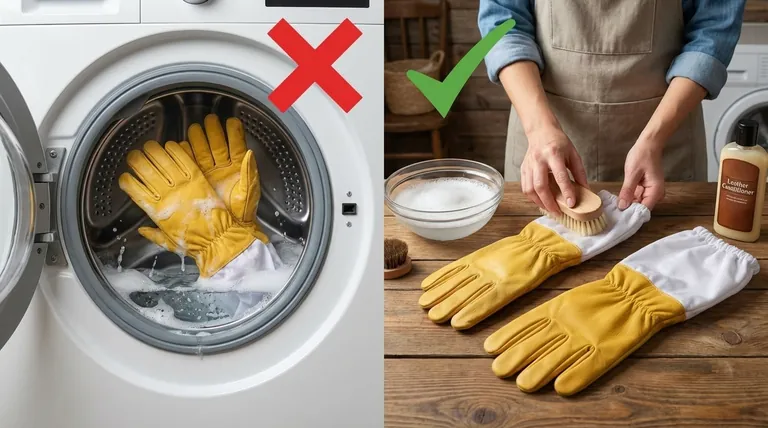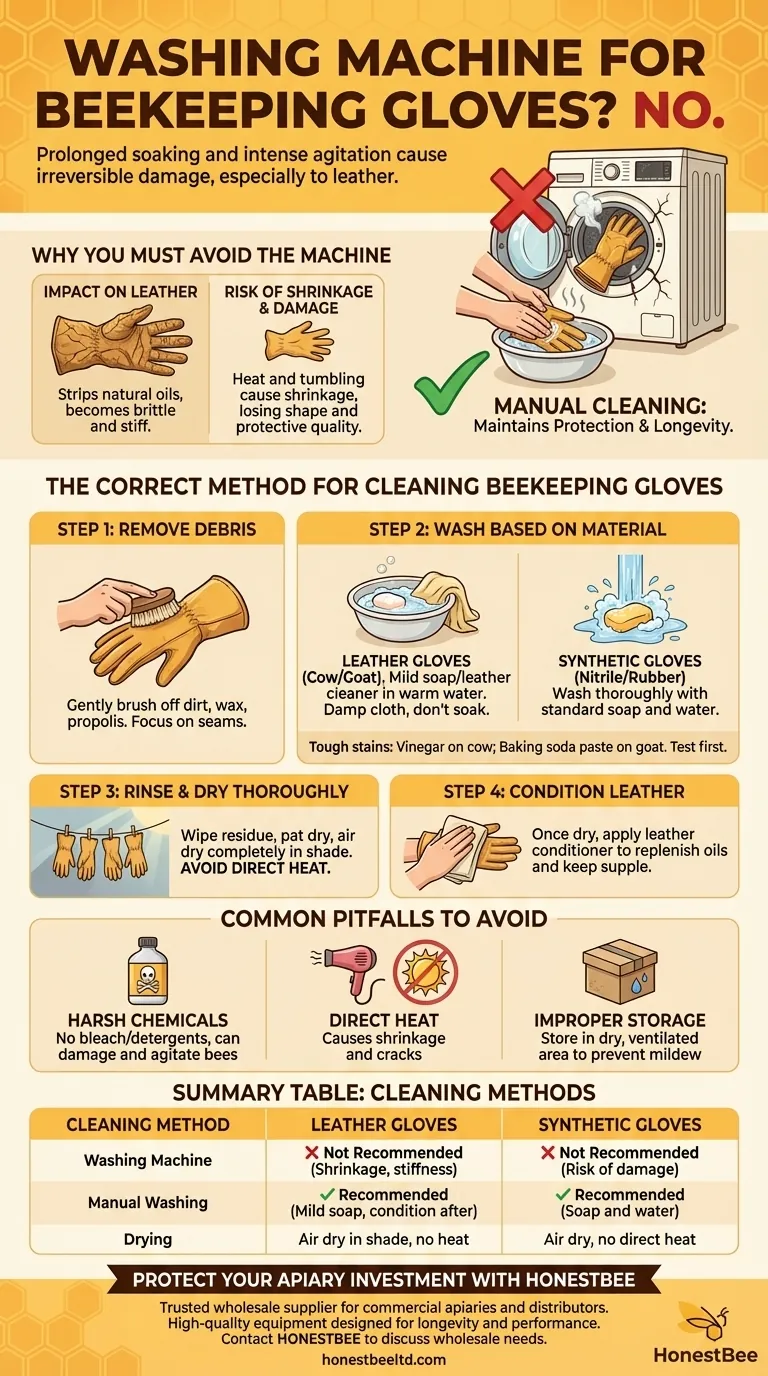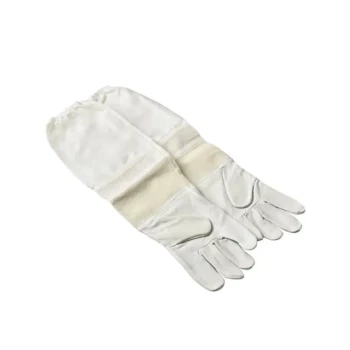No, it is not recommended to use a washing machine to clean beekeeping gloves. This is especially true for leather gloves, as the prolonged soaking and intense agitation of a washing machine can cause the material to shrink, stiffen, and degrade, severely shortening its lifespan.
The core issue is not just cleanliness but preservation. While a washing machine might remove surface dirt, it compromises the integrity of the glove's material, whereas proper manual cleaning maintains both protection and longevity.

Why You Must Avoid the Washing Machine
The Impact on Leather
Using a washing machine subjects leather gloves to a destructive combination of prolonged water saturation and forceful agitation. This process strips the natural oils from the leather, causing it to become brittle and stiff once it dries.
The Risk of Shrinkage and Damage
The heat and tumbling action, even on a gentle cycle, can cause the gloves, particularly leather ones, to shrink and lose their shape. This not only makes them uncomfortable but can also compromise their protective qualities by creating weak spots or tears.
The Correct Method for Cleaning Beekeeping Gloves
A gentle, manual approach is the only reliable method to clean your gloves without causing damage. The process varies slightly based on the material.
Step 1: Remove Surface Debris
Before introducing any water, use a soft-bristled brush to gently remove loose dirt, wax, and propolis from the surface of the gloves. Pay close attention to seams and crevices where buildup is common.
Step 2: Wash Based on Material
For leather gloves (cow or goat): Prepare a solution of mild soap or a dedicated leather cleaner in a bucket of warm water. Dip a soft cloth or brush into the solution, wring it out, and gently scrub the glove surface. Avoid completely soaking the leather.
For tough stains, you can use a targeted approach. On cow leather, test a small amount of white vinegar. On goat leather, a paste of baking soda and water can be effective, but always test on an inconspicuous area first.
For synthetic gloves (nitrile or rubber): These are much simpler to clean. You can wash them thoroughly with standard soap and water, as they are not susceptible to the same damage as leather.
Step 3: Rinse and Dry Thoroughly
After cleaning, wipe away any excess soap residue with a clean, damp cloth. Pat the gloves dry with a towel to remove as much moisture as possible.
Hang the gloves to air dry completely, preferably in the shade or indoors. Direct sunlight or a machine dryer will cause leather to crack and synthetic materials to degrade.
Step 4: Condition the Leather
Once leather gloves are completely dry, it is crucial to apply a leather conditioner. This step replenishes the oils lost during cleaning, keeping the material supple, flexible, and durable. Use a small amount, as a little goes a long way, especially on absorbent goat leather.
Common Pitfalls to Avoid
Using Harsh Chemicals
Never use general household cleaners, bleach, or strong detergents. These products can severely damage leather and may leave behind strong scents that can agitate or disturb your bees.
Applying Direct Heat
Do not use a machine dryer, hairdryer, or any other source of direct heat to speed up the drying process. This is the fastest way to make leather gloves shrink, crack, and become unusable.
Improper Storage
Once clean and dry, store your gloves in a dry, well-ventilated area away from direct sunlight. Proper storage prevents mildew and preserves the material for the next season.
How to Apply This to Your Gloves
A few key principles will ensure your gloves last for many seasons.
- If you have leather gloves: Your primary focus must be on gentle, surface-level cleaning and replenishing the material's natural oils with a conditioner.
- If you have synthetic (rubber or nitrile) gloves: Your cleaning process can be more straightforward with soap and water, but you must still prioritize air drying away from direct heat.
Properly cleaning your gloves is a small investment of time that pays off in longevity and reliable protection.
Summary Table:
| Cleaning Method | Leather Gloves | Synthetic Gloves |
|---|---|---|
| Washing Machine | ❌ Not Recommended (causes shrinkage, stiffness) | ❌ Not Recommended (risk of damage) |
| Manual Washing | ✅ Recommended (use mild soap, condition after) | ✅ Recommended (soap and water) |
| Drying | Air dry in shade, no heat | Air dry, no direct heat |
Protect your apiary investment with HONESTBEE's durable beekeeping supplies. Proper glove care is just the start. As a trusted wholesale supplier for commercial apiaries and distributors, we provide high-quality equipment designed for longevity and performance. Let our experts help you equip your operation with gear that stands up to the rigors of beekeeping. Contact HONESTBEE today to discuss your wholesale needs and ensure your beekeeping success.
Visual Guide

Related Products
- Beekeeping Gloves Goatskin Leather with Long Cotton Sleeve for Beekeepers
- Goatskin Leather Beekeeper Gloves with Vent Long Sleeve for Beekeeping Honey Bee Sting Proof Protection
- Mesh Ventilated 3 Layer Goatskin Beekeepers Gloves for Beekeeping
- Goat Skin Leather Bee Sting Proof Beekeeping Gloves with Canvas Sleeve
- Professional Galvanized Hive Strap with Secure Locking Buckle for Beekeeping
People Also Ask
- What should beekeepers consider regarding the fit of beekeeping gloves? Achieve Safety and Dexterity
- Should beekeepers wear gloves, and why? Essential Protection for Beekeepers
- Why are protective gloves important in beekeeping? Boost Confidence & Safety in Your Apiary
- What is the difference between cleaning cow leather and goat leather beekeeping gloves? Tailor Your Care for Longevity
- Why do some experienced beekeepers choose not to wear gloves? For Superior Dexterity & Hive Welfare



















